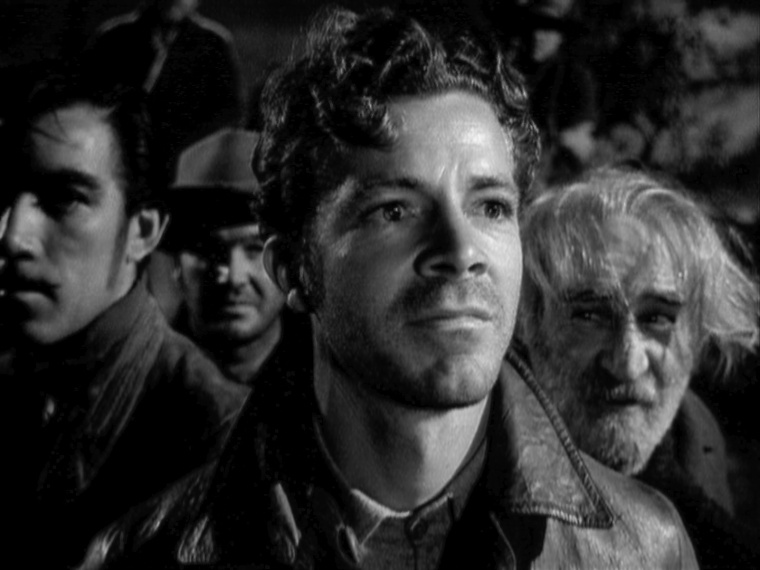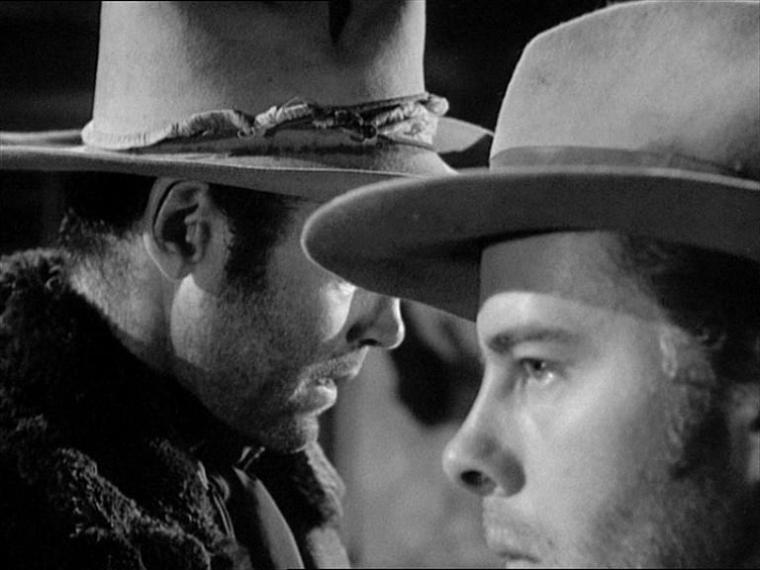
Dana Andrews (centre) realizes he’s being railroaded. Image: Dr. Macro
*Spoiler Alert
The trouble with creating a masterpiece is sometimes people don’t automatically see it as such.
One example is The Ox-Bow Incident, a 1943 western directed by William Wellman. This film was released during some of the darkest days of WWII and, as a result, it was a box office disappointment. Audiences were in no mood to be reminded of the failings of human nature, and you can’t really blame them.
Fortunately, the film was recognized with an Oscar nomination for Outstanding Motion Picture, and is now considered one of Wellman’s masterpieces.
The Ox-Bow Incident is based on a novel by the philosophical American writer, Walter Van Tilburg Clark. The story takes place in Nevada, in 1885, and tells us What Happens Next when a popular rancher is shot on his own land.
At first, we sympathize with the town’s decision to form a posse. How dare someone shoot our neighbour! Let’s get ’em, boys!
But we soon discover the town’s leaders may not be as keen on justice as they are on other pursuits. A posse provides an opportunity to teach a harsh lesson to a young man, for instance, or provide an outlet to satisfy one’s bloodlust.
It’s not a comfortable film to watch; ten minutes in, you know things are going to end badly. This is Wellman’s doing. He feeds us the narrative in a controlled way, even while events unravel quickly.
Wellman also has a way of torquing scenes with the use of close-ups. His camera forces us to scrutinize characters as they scrutinize each other. Close-ups in this film signify a challenge to, or defiance of, prevailing conditions.
In one scene, we focus on a man (Dana Andrews) who has been arrested by the posse. While the posse waits for the sheriff to arrive in the cold mountain night, the camera isolates Andrews. He watches a woman and a man sitting close together; the man whispers in the woman’s ear and she laughs loudly. This could be a midnight picnic, except it’s not. It’s a prelude to an execution.
The most significant close-up of this film is one of Henry Fonda, and Wellman intentionally hides his eyes from our view.

Henry Fonda (left) reads a letter that becomes an indictment. Image: ronhamprod.com
In this scene, near the end of the film, the men from the posse gather at the saloon. They are silent, glum, drunk.
Fonda opens a letter written by Andrews and, as he begins to read aloud, he leans against the bar, his back towards the others. Fonda’s eyes are hidden by the hat brim of his friend (Harry Morgan). We analyze Morgan’s expression instead, as he stares straight ahead while Fonda reads. Fonda’s voice is gravelly, betraying emotions he is trying to suppress.
Wellman has staged this close-up to force us to concentrate on the letter’s message. There’s nothing else to look at – no decor in the background, no supporting actor fidgeting with a whiskey glass. It’s Fonda and Morgan, and us.
We squirm a little as Fonda reads, because Wellman has brought us uncomfortably close to this letter.
The Ox-Bow Incident is a powerful, haunting film, and we can’t recommend it enough. Once you see it, you’ll agree that it deserves the reputation of a William Wellman masterpiece.
The Ox-Bow Incident: starring Henry Fonda, Dana Andrews, Mary Beth Hughes. Directed by William A. Wellman. Written by Lamar Trotti. Twentieth Century-Fox Film Corp., 1943, B&W, 75 mins.
This post is part of the William Wellman Blogathon hosted by Now Voyaging. Click HERE to see the schedule.













This sounds very good and thought provoking. It is so interesting how the director uses close ups to get a message across. I’m glad you pointed that out to me so I can focus on that when I see it. I love so many of the actors in this. I am putting it on my list and look forward to it. Thanks, Ruth!
LikeLike
This is an incredible movie and you’ll notice when you see it how the close-ups increase the tension. Very thought-provoking film.
LikeLike
I’m not much of a Western fan, but this is tops on my list! You did it justice!
LikeLike
Thanks so much. I love this western, but it’s not one I can watch very often. Such great acting by everyone, no?
LikeLike
This sounds fantastic and excellent observations on Wellman’s camera work. I found a copy on YouTube, I am going to see this tonight. Out of curiosity, do you know why Wellman is not covered as much as is his comtemporaries?
LikeLike
I’m not sure why Wellman isn’t discussed as much as his contemporaries. He led an interesting life and made some wonderful films. I’m hoping this blogathon will shed some light on that.
LikeLiked by 1 person
I just finished this movie, it is intense! Thank you for covering this film! I really love Wellman’s foreshadowing, and that painting with the woman just out of reach was a perfect metaphor for the entire film! Really enjoyable!
LikeLike
Ha – yes, this is one intense flick. There is sooo much to say about it, no? I couldn’t do it all in one post. I agree re: painting of woman as perfect metaphor. Thanks for letting me know what you thought of it. 🙂
LikeLiked by 1 person
Definitely one of Wellman’s greatest – he’s long been one of my favourite directors. You’ve done a great job in showing how the intensity builds up to an unbearable level in this one – amazing when you realise how short the running time for it is. I think he has started to be discussed more than he was in the past, and hopefully that will continue.
The cinematographer was Arthur C Miller who also worked on an amazing list of films – I just looked him up at the imdb and his career stretched from 1909 through to 1951. He also won three Oscars. I think this might have been the only time he worked with Wellman, though I’m not sure.
LikeLike
Thanks for heads up re: Arthur C Miller. I need to do more research on his lengthy career. As for the intensity in this film, you’re right. Wellman doesn’t let up for a minute!
LikeLiked by 1 person
Great post on a great movie! You did a great job, especially covering Wellman’s use of closeups. He seemed to always find a way to use the closeup in a new way and usually one that struck some sort of emotion in the audiences. Great post and thank you for taking part in this blogathon! 🙂
LikeLike
Yes, Wellman certainly knew what he was doing. I’m glad this film eventually received the recognition it deserved.
So glad you organized this blogathon so we can all learn more about him. 🙂
LikeLiked by 1 person
An uncomfortable film indeed. You said it all with your analysis of those potent scenes.
LikeLike
It’s a film you never forget.
LikeLike
Nice discussion of the film. I believe it was based on a short story by William Faulkner (at least that’s what I remember from my undergrad English college days :-D). I haven’t seen the film in a long time (as I’m not a huge fan of westerns) but I do remember that potent scene with Fonda reading the letter the dead man had in his pocket to his wife and how Fonda’s eyes were shielded through the whole scene.
Tam
LikeLike
That is a really potent scene, isn’t it, the one with Henry Fonda reading the letter. It’s haunting.
As for William Faulkner, if he really did write the short story this movie is based on, then he was supremely ripped off. Walter Van Tilburg Clark’s name and mention of his novel appear in the opening credits. I believe the success of Clark’s Ox-Bow Incident novel enabled him to give up teaching and devote himself full time to writing.
LikeLike
As always, an amazing article!
The close-ups are very effective when translating an emotion or thought to film. Wellman knew how to do it very well (I remember some key scenes of A Star is Born that use close-ups). I agree we know the film will end badly from the start, and that some masterpieces take time to be recognized as such.
Thanks for the kind comment!
Kisses!
Le
LikeLike
You’re right – close-ups are the most effective when translating emotion and Wellman does it so well. Thanks for dropping by!
LikeLike
I see we covered the same film. Have to say you made a great choice! The film is a masterpiece and as I have said to anyone who listens, it’s as relevant today as it was all those years ago. Great contribution!
LikeLike
Yes, we both have excellent taste, John. I’ll be by later to read your post – and learn something new, like I always do 🙂
LikeLike
Reblogged this on WILDsound Writing and Film Festival Review.
LikeLike